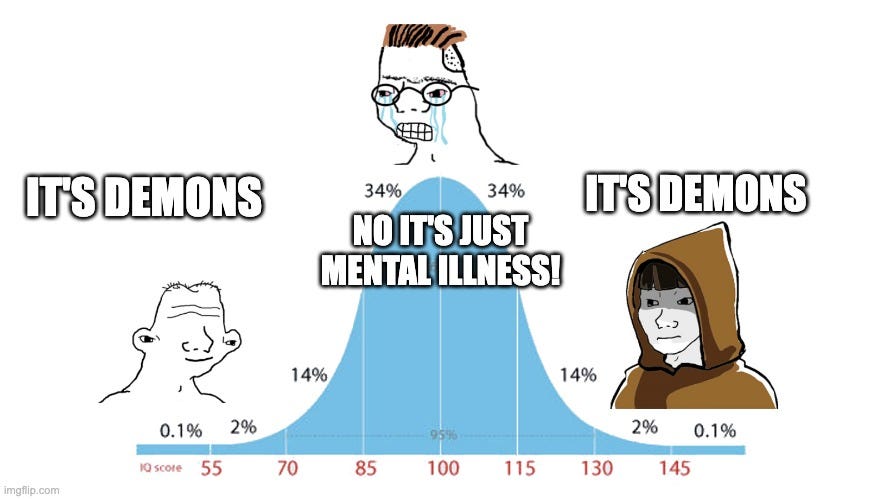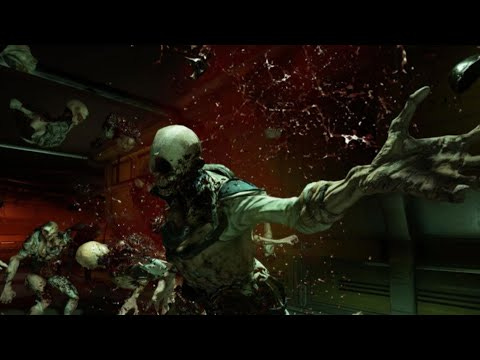Three years ago I wrote this about the “the ABA’ pattern” of reality:
In music theory this is the simple ternary form, like a minuet and trio: an opening section (A), followed by a contrasting second section (B), concluding with a repetition or variation on the original section (A’). The end of the journey ends up resembling the beginning, but given new meaning and substance by virtue of the middle section. …
The ABA’ process can play out in a single life. Take the child with blind faith in the religion of their parents (A) who as a teen and young adult goes through a period of agnosticism or violent atheism (B), only to return to their faith more mature, with a knowledge and inner understanding that was lacking in either of the previous stages (A’). Kind of like that T.S. Eliot quote.
I think our understanding of evil will eventually come to follow this form as well—a process that will have spanned centuries. Historically many physical and mental health problems were ascribed to demonic activity. Associate Professor of Religion and History Deeana C. Klepper recently made this point:
Through the 13th century, Klepper says, behaviors we might associate with mental illness were often thought to be caused by “demonic possession” — a demon taking full possession of a person’s body without their consent. But by the later 14th century, people began to avoid religious explanations for mental illnesses; instead, they spoke in medical terms about imbalances of the four humors in the human body as the cause of mental illness.
Those who did still see a spiritual source to such suffering began to speak in terms of “demonic obsession,” an attack from the outside that would cause sudden, irrational behavior or self-harm, Klepper says. An external demonic obsession might have allowed for “a more compassionate response to the mentally ill… as there was a clearer distinction between human and demon” and therefore “less fear of the demon’s lingering presence,” Klepper says.
In fact, Klepper says, one priest, Augustinian canon Albert from Bavaria, suggested in a 1370s Latin manual for German parish priests that those who “take their own life in the throes of that experience of demonic harassment” — demonic obsession — deserved to be buried with their loved ones, even though that was usually forbidden. This was a more compassionate view about people’s mental health than others in the region, Klepper says. During the same time period, some European city governments banished people who exhibited signs of mental illness.
Outside of religious communities, however, there is no room for any sort of demonic activity in the current understanding of mental illness, which is ascribed exclusively to genes and trauma. But as the strictly materialist worldview continues its slow death, this will open the door to new understandings of evil which may come to resemble those of the Medieval in certain ways.
I shared some of my thoughts on what this might look like in a few past posts:
And of course,
has covered the subject extensively over at .The article above, on Klepper, includes this:
Belief in demons goes back centuries, likely emanating from people’s fear of the unknown, of individuals who displayed behavior deemed to be strange or different.
Alternately, belief in demons may go back centuries because it is humanity’s attempt to describe some real aspect of the unknown that is inherently fearful—what I called “x” in my article on supernatural evil linked above. When x manifests in human behavior, it would naturally appear to us to be “strange or different.”
Just as I believe the universal franchise was a good idea taken to a pathological extreme, I think our present disenchantment of mental illness is the same. Humanity swung too far in the direction of a philosophical dead end. And as Klepper observes about Father Albert of Bavaria, it is possible to have a humane view of the mentally ill (or the “demonically” affected) without resorting to stoning schizophrenics in the town square.
To restate some basics of the way I see it, reality is fundamentally “cognitive” or “psychic” in nature and is composed of primarily two classes of “things” that are inextricably connected: physical actualities and nonphysical possibilities. (Modern philosophy tends to deny the reality of the latter, despite it being developed and expressed entirely through them, and ultimately predicated on them.) All human behavior has its origin in and is “filtered” through such behaviors’ nonphysical counterparts—which act as pre-existent templates of sorts. Some possibilities go unrealized, while others become actualized in physical reality. There is mentality or agency behind each actualization—the possibilities are not “randomly” actualized, nor are they actualized according to some law-like determinism.
Repetition, à la Rupert Sheldrake, favors or strengthens certain possibilities in a bottom-up process. For instance, virtues, practiced consistently, create a solid character, which is the actualization of one “possible you.” The future you is a multitude of possibilities. And until that character locks into place to become permanent—which in Stoicism was the achievement of Sage status, or in Dabrowski is called secondary integration—many possible “yous” compete for supremacy. Anyone who has battled with a vice or learned a new skill understands this. (The present you often feels the strongest and takes effort to dethrone.)
Life, according to this way of looking at things, is a war of competing possibilities, each vying for actualization. This can be expressed on the mundane level as persuasion, information warfare, and propaganda—each with the purpose of making certain possibilities more enticing, or blocking out alternate possibilities that might hinder the agenda of those doing the persuading. But there are wilder options. Some “future yous” may be veritable monsters. And some beings of the x variety may enjoy tormenting you and getting you to do horrible things, just as some humans enjoy doing.
Since every physical/mental state has a nonphysical correlate, and can be filtered through multiple layers of agency, I don’t think it’s crazy to posit that what we call mental illness is simply the expression of a certain class of nonphysical possibilities or attractors, a subset of which can be called demonic. In cases where the sufferer is tormented, the best explanation may be something like Father Albert’s “demonic obsession.” I think it at least possible that such an understanding may even produce more effective treatments than modern psychiatry has to offer, but modified by the best it has to offer. (Remember, ABA', emphasis on the '.)
“Demonic possession,” by contrast, may be explained as the eventual displacement of the original personality by a foreign consciousness after a process of targeted predation, one that bears little to no resemblance to who that person used to be. Alternately, it may represent the gradual actualization of one of those monstrous “future yous,” where everything that is not “it” has been chipped away and “deactualized” until only “it” remains. (Which may just be two ways of describing the same phenomenon.)
Mark sent me the following video for my thoughts a few weeks ago. It can’t be viewed on Substack, so click through to watch some or all of it. It’s about Zachary Davis, a 15-year-old who killed his mother with a sledgehammer back in 2012.
Note his emotionless, menacing demeanor and monotone delivery, then skip ahead to 45:26. When asked by police whether he always “looks at people through his eyebrows,” he can’t help but smirk. Dr. Phil interviewed him too. Here’s a clip.
And there’s that smirk again, as he describes the “wet, thumping sound” of striking his sleeping mother in the head with the sledgehammer. Here’s what Phil had to say prior to the interview clip:
From time to time in the last 45 years, I’ve encountered people that I thought transcended all the labels that we had and rose to the level of just being pure evil. I haven’t seen them very often, but there are times that I’ve encountered those that I thought, yeah, this goes to a whole other level. … When I arrived at the jail to interview Zachary Davis, the guards there really didn’t want to be in the same room with him. He was shackled, hands and feet, around his waist, but they seriously didn’t want to be in his physical space, because they sense such an evil energy around this individual.
Four experts at Davis’s trial came up with four different diagnoses, including schizophrenia, depression, and psychosis, and couldn’t agree on whether he was fit to stand trial. Davis claimed to have heard voices at least since the death of his father. His flat affect suggests some type of schizoaffective disorder. Was he malingering, putting on an act? His texts to his mother and brother seem like those of a normal teen, but many with personality disorders make a show of acting normal when they want to. He was fascinated by death and murder, and may have been deliberately trying to present as evil in front of police, but his brother said he always spoke in that quiet monotone.
Regardless of any of that, “by their fruits.” The young man bashed his mother’s skull in, told police he laughed while doing it (and actually laughed while recollecting it), and planned for his brother—his only friend—to die in the fire he started in their house. It’s not a question of mental illness or evil. In this case, it’s self-evidently both. Evil in this world is always a reflection of evil in the nonphysical world—whether mediated by other incarnate beings or not, and whether or not those beings are human.
Scientific detachment and methodological naturalism have served a purpose, but they will need to be combined with a more accurate philosophy if we are ever to more fully understand the nature of evil.






Excellent article, thank you. I am that ABA for sure. Lived through my 30(?) years of agnosticism/atheism, back into Christianity. I do believe demons have their grip on us, some more than others, and some times more than others. I have felt demon-free after intense depression caused by grief, but I don't believe I have anything close to a mental illness. I definitely agree that there is a metaphysical, spiritual, and physical plane... maybe more. And that spirits travel in and out of them. I find that scripture and prayer to God, and even mentioning Jesus, seem to reverse the spell or grip of demons. It's a thing! In any case, that's my experience.
For awhile there, when an atheist, I could not for the life of me understand how any scientist could also be a believer in God, much less a Christian.
C.S. Lewis helped me understand a lot.
https://engineering.purdue.edu/ECE/News/2021/purdue-engineering-launches-worlds-first-center-for-internet-of-bodies
https://pervasivecomputinginfo.blogspot.com/2018/10/ieee-802156-standard.html?m=1
https://stylman.substack.com/p/node-without-consent
https://horizons.service.canada.ca/en/2020/02/11/exploring-biodigital-convergence/
https://x.com/CorinneNokel/status/1890363924077301962
https://rumble.com/v6whgle-research-video.html?e9s=src_v1_cbl%2Csrc_v1_upp_a